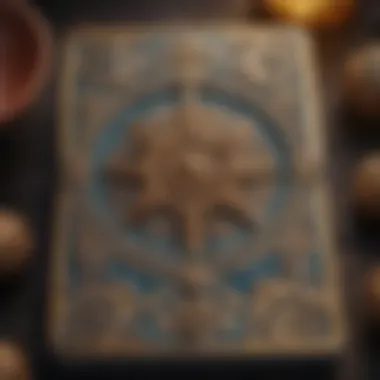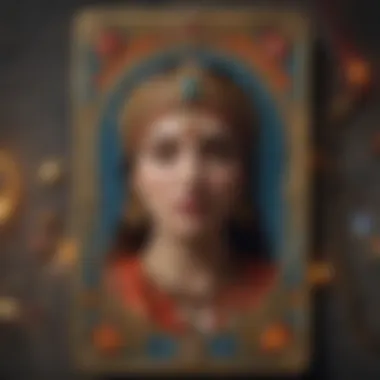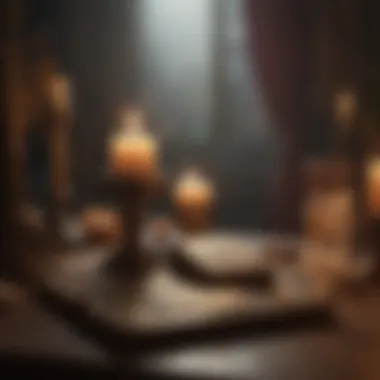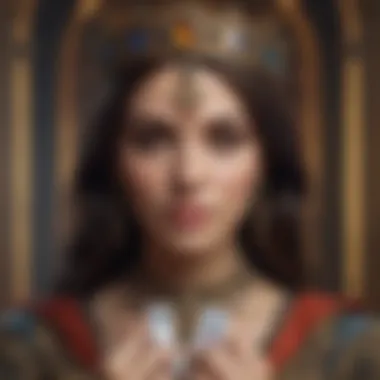Exploring Color Tarot Cards: A Comprehensive Guide


Intro
Color tarot cards offer a unique lens through which to explore the deeper meanings and implications tied to tarot readings. Unlike traditional tarot, where the imagery often centers on symbolism and archetypes, color tarot incorporates the psychological impact of colors. This intersection brings a vibrant and multi-faceted dimension to the cards, enhancing personal reflection and intuitive understanding.
Tarot has a rich history, drawing from various cultural practices and beliefs. The infusion of color symbolism into the tarot universe allows practitioners to connect more deeply with their readings, providing layers of meaning that may not be immediately apparent. The purpose of this guide is to inform readers about the significance and applications of color in tarot, how to effectively navigate color tarot cards, and explore their psychological resonance.
By understanding the dynamics at play, tarot enthusiasts can use these tools not just for divination, but also for personal growth and self-discovery. This guide will cover the various aspects of color tarot cards, including historical context, interpretation methods, and practical tips for choosing the right deck, all while unpacking the psychological importance that colors hold.
Zodiac Profiles
Overview of Each Sign
Incorporating astrology into the realm of color tarot enriches the reading experience. Each zodiac sign carries its unique characteristics, resonating with specific colors, thus allowing for deeper connections and insights.
Personality Traits
When examining the zodiac signs, their inherent traits become crucial for understanding how colors influence and reflect their nature. For example:
- Aries: Red signifies passion, energy, and assertiveness.
- Taurus: Green represents stability, harmony, and growth.
- Gemini: Yellow embodies curiosity, communication, and liveliness.
Strengths and Weaknesses
Analyzing strengths and weaknesses through color can also illuminate how these traits manifest. Consider:
- Aries Strengths: Initiative and courage; color enhances their dynamic personality.
- Taurus Weaknesses: Stubbornness; green can remind them of the importance of adaptability.
By acknowledging these attributes, color tarot can facilitate a more nuanced interpretation of readings. The blending of color psychology and astrology aids in illuminating personal development pathways.
Compatibility Insights
Love and Relationships
Compatibility in love can be observed through both zodiac signs and color associations. Understanding these elements offers deeper insights into personal dynamics.
Friendship Compatibility
Certain colors resonate differently among friends, revealing underlying affinities or tensions. Knowing what colors your friends feel drawn to can enhance connection.
Workplace Dynamics
In professional settings, color's psychological implications can affect teamwork and communication. Being aware of these factors can promote healthier working relationships.
Astrological Events
Monthly/Weekly Horoscope Breakdown
Astrological events have significant effects on individual behaviors. Keeping track of horoscopes can help guide how to utilize color tarot effectively during different lunar phases.
Notable Celestial Events
Key celestial occurrences can trigger shifts in energy, affecting the use of color tarot cards. Awareness of these events can prepare practitioners for changes in readings.
How to Prepare for Astrological Shifts
Being equipped to handle astrological shifts through color tarot cards can provide stability. Utilize color associations linked to planetary shifts for enhanced clarity in readings.


Color tarot cards serve as potent tools for personal exploration, providing fruitful avenues for understanding oneself and the world. In combining color psychology with tarot and astrology, practitioners find a way to express thoughts, feelings, and insights with profound depth.
Prolusion to Color Tarot Cards
Understanding the role of color in tarot is essential for both novice readers and seasoned practitioners. Color tarot cards add a layer of depth, amplifying the meanings traditionally associated with the tarot. This section will unpack the significance of color tarot cards, highlighting their unique attributes, benefits, and the considerations that come with their use.
Definition of Color Tarot Cards
Color tarot cards are distinct decks that incorporate a spectrum of colors to convey meaning and influence the interpretation of readings. Each card typically uses a rich palette designed to evoke emotions and thoughts that align with the card’s traditional themes. Color might not just be a visual enhancement; it serves as a critical component that reflects psychological states and spiritual energies. Through their vivid hues, these cards engage the viewer's intuition in ways standard black-and-white decks may not.
When individuals draw a color tarot card, the colors can impact the emotional resonance of the reading. Whether it is bright reds or soft blues, each shade speaks to different human experiences, allowing for a deeper understanding of the query at hand. Essentially, color tarot cards create a multisensory experience, bridging visual stimulation with intuitive insights.
History and Evolution
The use of color in tarot can be traced back centuries, as artists and mystics have sought to infuse meaning into every aspect of their craft. The origins of tarot date back to the late 14th century, but it was not until the 18th century that color started to play a prominent role in interpretations and deck designs. Early decks like the Tarot de Marseille featured some color but were often limited in palette and depth.
With the rebirth of interest in tarot during the 20th century, particularly the Tarot Rider-Waite-Smith, colors began to take on significant meaning. The use of a broader range of colors offered new interpretations and greater emotional engagement. Artists and creators began to explore the psychological implications of color, studying how different shades affected readers' perceptions. This exploration gave rise to countless decks with strong thematic colors, underscoring the role of color as a psychological tool in divination.
Today, the evolution of color tarot cards reflects society’s increasing appreciation of personal interpretation and emotional resonance. Each deck available on the market presents unique color schemes, highlighting the individual’s tendencies, emotions, and life circumstances. This trend ensures that color tarot cards remain pertinent and accessible for those looking to deepen their connection with the tarot.
"Color is the keyboard, the eye is the hammer, the soul is the piano with many strings." - Wladimir V. Propp
Understanding the history and significance of color in tarot cards enriches our comprehension and enhances our readings. By recognizing the evolution from basic black and white to vibrant color, readers can appreciate the depth and nuances color brings to this ancient practice.
The Psychology of Color in Tarot
Understanding the psychology of color in tarot is essential for anyone looking to delve deeper into their tarot practice. Colors do more than just please the eye; they evoke emotions and provoke thoughts. The mindful selection or interpretation of colors in tarot enhances the intuitive experience. This section aims to shed light on the importance of color psychology in tarot readings, and how it affects perception, emotions, and overall readings.
Understanding Color Perception
Color perception is a fundamental aspect of our daily experiences. It influences how we perceive the world, interact with others, and make decisions. In tarot, the colors associated with each card can bring added depth to the reading. These colors resonate on various levels, both psychological and emotional, allowing individuals to connect with cards on a personal level.
For example, warm colors like red or orange may convey feelings of energy and passion. On the other hand, cooler colors such as blue may induce tranquility or introspection. Understanding this perception helps the reader and the querent form deeper connections with the tarot cards.
Emotional Associations with Colors
When it comes to color, certain hues hold universal emotional meanings. This shared understanding can help inform tarot readings. For instance:
- Red: Often signifies passion, love, and aggression.
- Blue: Associated with peace, trust, and wisdom.
- Green: Represents growth, balance, and renewal.
- Yellow: Evokes joy, clarity, and intellect.
- Black: Often symbolizes mystery, protection, or the unknown.
- White: Signifies purity, beginnings, and possibilities.
By fostering an awareness of these associations, tarot practitioners can raise the emotional intelligence of their readings. The potential to tap into these emotions enhances both the reader's and querent’s experience, making it more profound.
Impact of Color on Intuition and Readings
Color plays a significant role in shaping intuition during tarot readings. It can trigger instinctual responses, influencing how readers interpret the significance of the cards. When a card is drawn, the colors within it may spark memories or feelings that can guide the reader toward a specific interpretation.
Additionally, colors may help a reader focus their energy and intention. For example, during a reading involving conflict, a card dominated by red might be interpreted as heightened emotions or struggles. In contrast, a blue card might suggest the need for calm deliberation or resolution.
The overall impact of color on intuitive processes is crucial. It does not just encourage interpretation based on logical meanings but invites a multi-dimensional approach to understanding cards. This synergy between color and intuition is what makes color tarot readings dynamic and engaging.
Key Point: The intersection of color psychology and tarot enhances the depth of readings, encouraging both the reader and the querent to explore emotional and intuitive aspects deeply. The right understanding can transform card meanings in powerful ways.
Key Colors and Their Meanings in Tarot
Understanding the meanings of colors in tarot is crucial. Each color brings its unique energy and symbolism which influences the interpretations of cards. By knowing these meanings, practitioners can uncover deeper insights and offer more precise readings. Colors resonate with emotions and instincts, helping to enhance one's understanding of the tarot.


Red: Energy and Passion
Red represents strong feelings and intense moments. It embodies energy, passion, and action. When red appears in a reading, it often signals the presence of vitality and motivation. This color can also indicate challenges or conflicts that require immediate attention. In practical terms, the presence of red can encourage one to take action or assert themselves.
Blue: Calm and Intuition
Blue is often associated with tranquility and peace. It encourages deep thought and enhances intuition. In tarot readings, a blue card may suggest a need for reflection or calmness, guiding one to connect with their inner wisdom. It may also indicate effective communication and clear expression of thoughts. Thus, blue serves as a reminder to pause and listen, both to oneself and others.
Green: Growth and Stability
The color green symbolizes growth, fertility, and stability. It resonates with nature and renewal. When green arises in a reading, it often emphasizes personal development and evolution. This color signifies a time for nurturing and cultivating relationships or projects. Green suggests that grounding oneself can lead to fruitful outcomes, promoting harmony with one’s environment.
Yellow: Clarity and Enlightenment
Yellow signifies clarity, optimism, and enlightenment. It is often linked to intellect and the pursuit of knowledge. A yellow card can indicate an upcoming realization or discovery, leading to a more profound understanding of life. Furthermore, it encourages positivity and forward thinking, reminding individuals to embrace the bright side of situations, even in adversity.
Black: Mystery and Protection
Black encompasses both mystery and protection. It represents the unknown and often evokes curiosity. When black appears in a tarot reading, it can symbolize hidden fears or potential, urging one to delve deeper into themselves. Black can also signify boundaries and the need for protection. This color serves as a shield, guiding individuals in navigating challenging circumstances.
White: Purity and New Beginnings
White is a powerful color that signifies purity and new beginnings. It represents blank slates and fresh starts, making it essential in the context of transformation. In tarot, a white card may suggest the need for cleansing or clearing away old energies to embrace new opportunities. It reminds one of the importance of renewal and the potential that lies ahead.
Each color in tarot carries weight and meaning. By understanding these colors, one can unlock a richer understanding of their readings and journey with tarot.
How to Choose the Right Color Tarot Deck
Choosing the right color tarot deck is a critical aspect in your tarot practice. A well-selected deck can align with your intuitive skills and enhance your readings. Conversely, a mismatched deck might impede your connection to the cards. The process of selection involves various factors, including aesthetics, personal preferences, and functionality. Understanding these elements is essential to ensure a rewarding tarot experience.
Factors to Consider
When selecting a color tarot deck, several factors should guide your decision. These include:
- Art Style: The artistic style of the deck should resonate with you. Some prefer modern interpretations, while others favor classic or traditional art.
- Color Palette: Each color evokes specific emotions and meanings. Pay attention to how the colors in the deck impact your intuition and feelings.
- Card Stock and Size: The physical attributes of the cards affect how they feel in your hands. A sturdy card stock ensures durability, while the size should be comfortable for you to shuffle and handle.
- Guidebook: A companion guidebook is helpful. It should provide insights into interpretation, color meanings, and spreads.
- Theme: Some decks embrace a specific theme, such as nature, mythology, or celestial beings. Choose a theme that speaks to your interests and beliefs.
Popular Color Tarot Decks
Several decks are popular for their unique use of color and art style. Here are a few notable mentions:
- The Rider-Waite Tarot: While traditional, the vibrant colors in this deck are indicative of deeper meanings and interpretations.
- The Light Seer's Tarot: This modern deck is known for its beautiful illustrations and emotionally resonant color choices.
- The Tarot of the New Vision: This deck provides a fresh perspective with its vivid colors and reimagined imagery.
- The Prismavision Tarot: Celebrated for its striking colors and contemporary style, it offers a unique take on tarot reading.
Balancing Aesthetics and Functionality
Finding a balance between aesthetics and functionality is vital. While the visual appeal of a deck can be captivating, functionality should not be overlooked. A deck with stunning art but cumbersome cards may not suit your needs. Conversely, a highly functional deck lacking in visual quality might not inspire you.
Consider the practical aspect of how you plan to use your deck. For personal readings, a visually stimulating deck may enhance your experience, while for client readings, functionality may take priority. It is important to ensure that the deck allows for both intuitive engagement and practical application.
The right tarot deck can significantly influence your reading experience, bridging the gap between intuition and interpretation.
Ultimately, choosing the right color tarot deck involves a thoughtful combination of these aspects. Investing time to explore various options will help you find the deck that not only captivates your eye but also resonates with your soul.
Interpreting Color Tarot Readings
Interpreting color tarot readings is a fundamental aspect of engaging with tarot as a meaningful practice. The inclusion of color adds an additional layer to traditional tarot reading. It allows for a richer exploration of symbolism and personal insight. Color can evoke emotions and associations that enhance understanding during readings. This intersection between color and tarot is essential not just for intuitive comprehension but also for applying tarot in everyday situations.


Basic Interpretation Techniques
Basic interpretation techniques for color tarot readings emphasize the relationship between the card imagery and the colors present. Begin by observing the dominant colors on each card. Each hue conveys specific meanings that contribute to the overall message.
- Take note of emotional reactions: Pay attention to how each color makes you feel. If red evokes enthusiasm, while blue brings tranquility, let these feelings inform your interpretation.
- Consider the context: Look at how the color relates to the card's position in the spread. A card representing hope enhanced by bright yellow may shift its meaning significantly.
- Explore traditional meanings: Reference classic associations linked to colors, such as green for growth or black for mystery. Combine these established meanings with your intuitive feelings.
- Use journals: Keep a tarot journal where you note your interpretations of colors alongside traditional meanings. This practice will enhance your understanding over time.
Integrating Color Meanings into Readings
Integrating color meanings into readings requires a thoughtful approach. This process allows practitioners to layer insights effectively. When reading for oneself or others, actively involve color associations in messages conveyed.
- Use colors as intuitive guides: When discussing issues, ask the querent which colors resonate with them. This can reveal underlying emotions at play.
- Mix color meanings with card interpretation: Instead of treating colors and symbols separately, explore how they complement each other. For instance, a card of personal boundaries in blue may indicate a calm but firm stance.
- Ask reflective questions: Encourage those you read for to consider what the colors in their cards represent in their lives. How does green connect to their current growth, or how does yellow affect their clarity of thought?
Case Studies and Example Readings
Examining case studies can provide clarity on how to navigate color tarot readings. Here are a few examples that demonstrate the critical interplay between color and card interpretation.
Example 1: A reading with the Eight of Cups, predominantly displayed in deep blue tones. The querent feels stuck in emotional patterns. Here, the blue suggests calm but also distance from emotional exploration. This interpretation leads to a conversation about what barriers they could remove to encourage warmth in connections.
Example 2: The Sun card featuring bright yellow symbolizes joy and success. During a reading, the querent relates to the essence of opportunity but feels hesitant. The color brightens up the message, urging them to seize chances without fear.
By using these case studies, tarot readers can visualize practical implications of interpretations, combining elements of color psychology and traditional symbols for a more comprehensive understanding.
Practical Uses of Color Tarot Cards
Color tarot cards serve multiple practical functions in the realm of tarot reading. Understanding these uses is essential for enthusiasts looking to integrate color symbolism into their readings. The application of color enhances the depth of tarot, providing additional layers of meaning and insight.
Self-Reflection and Personal Growth
Color tarot cards can be an effective tool for self-reflection. Each color resonates with different aspects of the psyche, allowing individuals to explore various emotional states and motivations.
By using these cards, one can identify personal strengths and weaknesses. For instance, a card with a strong red hue may prompt reflection on issues of passion or aggression in one’s life. Conversely, a card displaying calm blues can inspire thoughts about tranquility or intuition. The process of interpreting these colors can lead to personal growth through greater self-awareness. This reflective practice helps understand personal trajectories and goals more clearly.
Guiding Life Decisions
Another practical application of color tarot cards is their role in guiding life decisions. The insights gleaned from the colors can clarify decisions and dilemmas.
When faced with a significant choice, drawing a few cards with vibrant color schemes can aid in understanding the underlying currents influencing the situation. For example, a card predominantly featuring green might suggest a path toward growth or healing, while a black card could denote caution or complexity in the decision-making process. Relying on these color associations can provide useful insights that are often overlooked in traditional readings.
Enhancing Relationships and Communication
Color tarot cards can significantly improve relationships and communication. The unique associations of colors can inform how individuals interact with others.
For instance, using a yellow card in discussions may help foster openness and clarity, encouraging honest dialogue. On the other hand, drawing a pink card may enhance feelings of love and compassion within a relationship. The awareness of how colors impact emotions allows for more thoughtful communication strategies. By considering the color's meaning, one can approach interactions with empathy and understanding, fostering deeper connections in personal and professional relationships.
Color can profoundly influence our internal states and external interactions. It's vital to recognize this power while engaging with tarot.
Epilogue: The Significance of Color in Tarot
Color plays a crucial role in the practice of tarot. Each hue imbues a card with specific meaning and emotional resonance. Understanding these colors can enhance one's reading and interpretation skills. This conclusion summarizes the importance of integrating color symbolism into tarot practice.
Summary of Key Insights
The exploration of color in tarot reveals several important insights:
- Psychological Impact: Colors influence emotions and perceptions, affecting both the reader and the querent. An awareness of this can enhance intuitive abilities during readings.
- Symbolic Meanings: Each color carries distinct meanings. For example, red often symbolizes energy and passion, while blue evokes calm and intuition. Knowing these associations is vital for proper interpretation.
- Practical Application: Color tarot cards can serve various purposes, from personal reflection to guiding life decisions. Engaging with these cards encourages deeper insight into one’s life path and relationships.
- Choice of Deck: The right color tarot deck can resonate more deeply with the user, combining aesthetic appeal with meaningful interpretations.
It is valuable to keep in mind that colors are not only visual elements but also emotional conduits that enhance the reading experience.
Encouragement for Further Exploration
For those intrigued by the significance of color in tarot, further exploration is encouraged. Consider the following pathways:
- Experiment with Different Decks: Try various color tarot decks to discover how certain colors resonate with you. See how they influence your readings.
- Study Color Theory: Delve into color psychology and theory to better understand the emotional and psychological impacts of colors.
- Join Tarot Communities: Engaging with groups on platforms like Reddit or Facebook can provide valuable insights and shared experiences.
- Practice Daily Readings: Utilize your insights about color in daily tarot practices. Reflect on how specific colors can guide interpretations.



